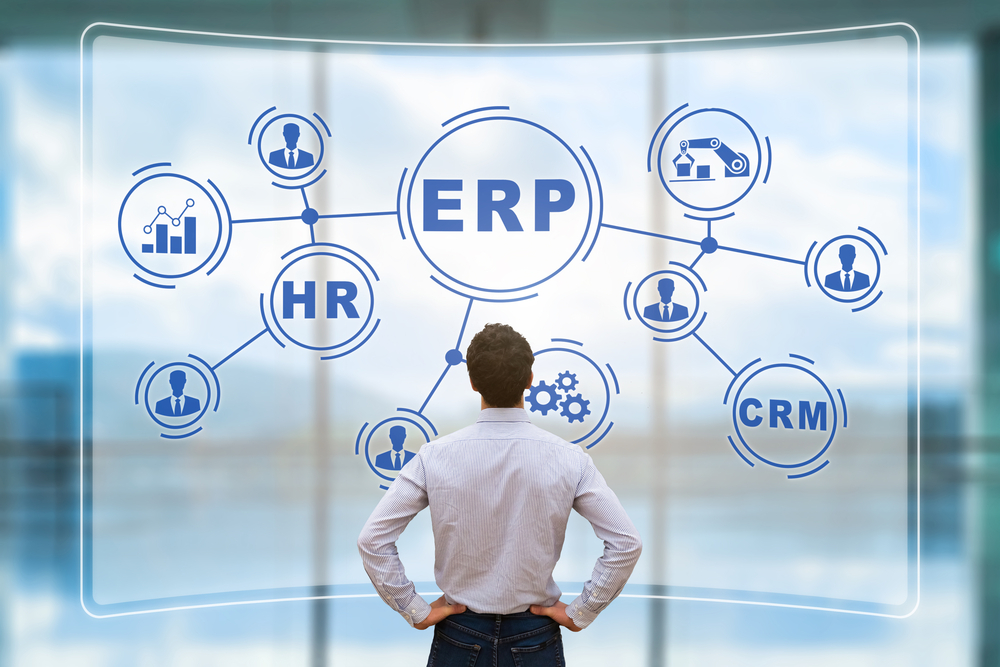
What Is ERP, and How Does It Work?
6min read
An enterprise resource planning (ERP) system is a robust digital platform that combines all your core business processes under one roof. ERP platforms provide an all-in-one solution for overhauling your operations and gaining actionable insights into company health.
But exactly what is ERP, and how does it work? Here, we’ll tell you the essentials so you can decide whether an ERP platform is the right investment for your business.
What is enterprise resource planning (ERP)?
Enterprise resource planning involves connecting your business operations via an integrated software solution. It unifies inventory, sales, marketing, human resources, finance, and other processes in an all-in-one platform. These applications are often called “ERPs” or “ERP platforms.”
A traditional technology framework compartmentalizes all your data. With information scattered across disjointed systems, your team may struggle to fulfill its responsibilities. ERP informs your decision-making and maximizes your team's productivity by consolidating most business applications.
Maintaining such a robust system may sound overwhelming for a small organization, but different service models exist to suit businesses of all sizes. There are three primary types of ERP implementation:
- On-premises: This solution requires on-site servers and hardware, which you’re responsible for purchasing, installing, and managing.
- Cloud-based: This deployment framework employs cloud computing resources and servers, decreasing your upfront costs and ongoing maintenance expenses.
- Hybrid: A hybrid model uses both on-premises hardware and cloud resources.
Many businesses prefer the cloud-based approach, as it’s exceptionally scalable and cost-effective. However, you may need an on-premises or hybrid system if you’re integrating legacy programs with your ERP.
ERP platforms are modular; they offer a broad selection of applications, and you can implement as few or as many as you’d like. Naturally, the fewer you include, the lower the cost. You can purchase additional app licenses and add them to your ERP as your needs change.
How does ERP work?
Most ERP providers use a customizable software-as-a-service (SaaS) delivery model. Here’s how it works:
- You choose your platform and deployment type (e.g., cloud-based, on-premises, or hybrid).
- You select the applications you want.
- The provider installs the platform and apps on the server.
- You collaborate with them to integrate your processes and data into the system.
Several factors impact an ERP’s cost, including:
- The number of users you enroll
- The number of apps you implement
- Your data and resource consumption
Most providers charge a recurring monthly or annual licensing fee, which is calculated based on the above factors. This fee structure gives you more control over your spending.
ERP vs. CRM
Customer relationship management (CRM) platforms are another frequently used business solution.
CRMs also help share information, automate workflows, and analyze data. Like ERPs, CRMs are often delivered via a SaaS model with flexible features and fees.
That said, ERPs and CRMs differ in several essential ways — most notably, their scope.
A CRM supports your customer service, marketing, and sales processes, whereas an ERP addresses nearly every aspect of your business. Most businesses find that they need both a CRM and an ERP solution. Some ERP platforms even include built-in CRM capabilities.
ERP examples

Let’s look at three of the leading ERP systems examples:
SAP
SAP ERP is an incredibly flexible solution that’s chock-full of features. It’s ideal for businesses of all sizes, from small companies to tightly regulated multinational enterprises.
Oracle
Oracle’s complexity and high implementation costs make it a poor match for most small businesses. However, it’s exceptionally dynamic and scalable — ideal for companies that want to manage every aspect of their operations within a single platform.
Microsoft Dynamics 365
Microsoft Dynamics 365 is best suited for small to mid-sized businesses, especially those already using Microsoft applications, such as SharePoint and Office.
The history of ERP
ERP solutions weren’t always digital. Enterprise resource planning technology has its roots in the economic order quantity (EOQ) model, developed by Ford Whitman Harris in 1913 to optimize inventory management.
Black and Decker further advanced the field by adopting the first material requirements planning (MRP) solution in 1964, which integrated EOQ concepts into the company’s mainframe computer.
MRP II introduced modular tools for resource and operations management in the 1980s. By 1990, industry experts had dubbed this class of software “enterprise resource planning.” ERP technology has evolved continuously ever since.
Benefits of ERP
Here are just a few benefits of using ERP platforms:
Enhanced collaboration
An enterprise resource planning solution tears down barriers between teams and departments by giving your staff a shared set of tools. They can share data and collaborate, all within a single platform.
Improved visibility
Stop piecing together business performance data using a grab bag of applications. Instead, implement an ERP to achieve end-to-end visibility and streamline your decision-making processes.
Simplified product lifecycle management (PLM)
Take control of the product development lifecycle and ensure a strong ROI on every new project.
End-to-end integrations
The end-to-end integrations featured in leading ERP platforms eliminate the need for redundant manual data entry. This translates to substantial cost savings for your business and less burden on your staff.
Challenges of ERP
Before committing to an enterprise resource planning solution, it’s wise to familiarize yourself with some potential ERP integration challenges.
Cost
An ERP’s initial cost can be significant, especially if you lack a robust in-house IT team.
Complexity
ERP implementation and configuration is a complex project that can take months to complete.
Learning curve
ERPs are designed to be user-friendly, but such a fundamental change to your operations may pose a steep learning curve for your staff.
Why move to an ERP cloud solution?

You can accomplish the following goals by moving to a cloud-based ERP solution:
Adopt emerging technologies
If you want to adopt the latest tech and tools, such as API-powered EDI communication software, a cloud-based ERP can help. Leading ERPs integrate with various native and third-party tools, giving you the flexibility to adapt.
Extend the value of legacy tech
If you already have an ERP and aren’t ready to replace it, consider moving it to the cloud. Doing so can add years of usability and give you additional time to plan your next move.
Reduce your dependency on third-parties
Managing dozens of software licenses compounds your IT costs (and causes logistical headaches in the process). Replace multiple third-party apps with a unified ERP platform to reduce your dependency on third parties and protect business continuity.
Evolve your business model
Evolution is essential if you want to maintain a competitive edge. An ERP helps streamline your business model and empowers you to capitalize on emerging growth opportunities.
Promote data security
The digital ecosystem is rife with threats. Bolster your security with a cloud-based ERP system and keep your data out of the wrong hands.
Make the most of your new investment with Orderful
Orderful can help you maximize your new ERP investment by simplifying your ERP/EDI integration. Our cloud-based platform gives you the agility to keep your trading partners in the loop and accelerate the flow of information across the supply chain.
Contact us today to schedule a talk with one of our EDI experts and learn how Orderful can revolutionize your business operations.
Go live with new trading partners in days, not months. Orderful’s modern EDI platform standardizes integrations and streamlines testing, getting your business connected with partners 10x faster than other solutions.
Learn Morenewsletter

Talk to an EDI Expert today
Join us on the journey to change the way the world trades EDI
schedule a demo →